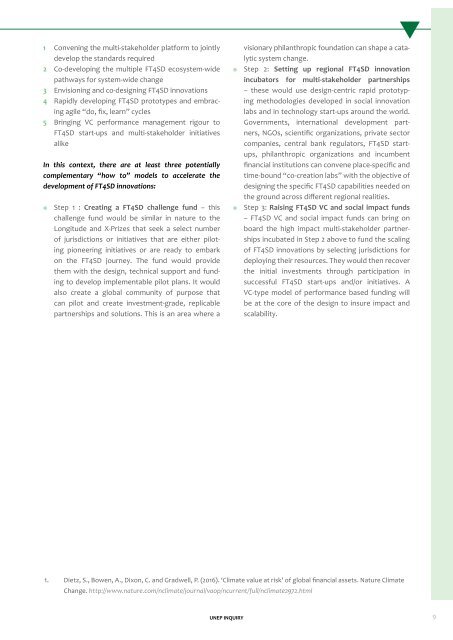FINTECH AND SUSTAINABLE DEVELOPMENT
2hAXoqq
2hAXoqq
Create successful ePaper yourself
Turn your PDF publications into a flip-book with our unique Google optimized e-Paper software.
1 Convening the multi-stakeholder platform to jointly<br />
develop the standards required<br />
2 Co-developing the multiple FT4SD ecosystem-wide<br />
pathways for system-wide change<br />
3 Envisioning and co-designing FT4SD innovations<br />
4 Rapidly developing FT4SD prototypes and embracing<br />
agile “do, fix, learn” cycles<br />
5 Bringing VC performance management rigour to<br />
FT4SD start-ups and multi-stakeholder initiatives<br />
alike<br />
In this context, there are at least three potentially<br />
complementary “how to” models to accelerate the<br />
development of FT4SD innovations:<br />
<br />
Step 1 : Creating a FT4SD challenge fund – this<br />
challenge fund would be similar in nature to the<br />
Longitude and X-Prizes that seek a select number<br />
of jurisdictions or initiatives that are either piloting<br />
pioneering initiatives or are ready to embark<br />
on the FT4SD journey. The fund would provide<br />
them with the design, technical support and funding<br />
to develop implementable pilot plans. It would<br />
also create a global community of purpose that<br />
can pilot and create investment-grade, replicable<br />
partnerships and solutions. This is an area where a<br />
<br />
<br />
visionary philanthropic foundation can shape a catalytic<br />
system change.<br />
Step 2: Setting up regional FT4SD innovation<br />
incubators for multi-stakeholder partnerships<br />
– these would use design-centric rapid prototyping<br />
methodologies developed in social innovation<br />
labs and in technology start-ups around the world.<br />
Governments, international development partners,<br />
NGOs, scientific organizations, private sector<br />
companies, central bank regulators, FT4SD startups,<br />
philanthropic organizations and incumbent<br />
financial institutions can convene place-specific and<br />
time-bound “co-creation labs” with the objective of<br />
designing the specific FT4SD capabilities needed on<br />
the ground across different regional realities.<br />
Step 3: Raising FT4SD VC and social impact funds<br />
– FT4SD VC and social impact funds can bring on<br />
board the high impact multi-stakeholder partnerships<br />
incubated in Step 2 above to fund the scaling<br />
of FT4SD innovations by selecting jurisdictions for<br />
deploying their resources. They would then recover<br />
the initial investments through participation in<br />
successful FT4SD start-ups and/or initiatives. A<br />
VC-type model of performance based funding will<br />
be at the core of the design to insure impact and<br />
scalability.<br />
1. Dietz, S., Bowen, A., Dixon, C. and Gradwell, P. (2016). ‘Climate value at risk’ of global financial assets. Nature Climate<br />
Change. http://www.nature.com/nclimate/journal/vaop/ncurrent/full/nclimate2972.html<br />
UNEP INQUIRY<br />
9


